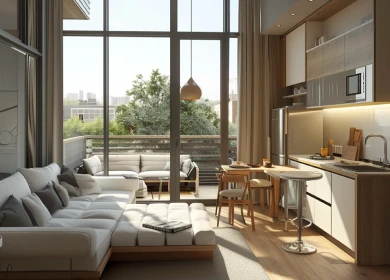Updated: 26 Dec, 2024
CoreLogic’s Home Value Index recorded a sixth straight month of decline in October, falling 1.2%.
All eight capital cities and most rest-of-state regions (excluding regional south Australia) recorded a drop. The month-on-month decline ranged from a 2.0% fall in Brisbane to a 0.2% fall in Perth, while across regional areas, monthly falls were recorded as follows: Regional NSW (1.7%), Regional Victoria (1.4%) and Regional Queensland (1.3%). The decline has eased compared with the previous few months in most places, however, with only a few places, including Brisbane, witnessing an accelerated price decline.
CoreLogic research director Tim Lawless said it was still too early to say definitively that the decline was past its worst phase. “Despite the easing in the pace of decline, with Australian borrowers facing the double whammy of further interest rate hikes along with persistently high and rising inflation, there is a genuine risk we could see the rate of decline re-accelerate as interest rates rise further and household balance sheets become more thinly stretched.”
House Values Drop Faster Than Unit Values
House values fell at a faster rate than unit values in October. Capital city house values were down 1.2% over the month, compared with a 0.7% decline in unit values.
The underperformance of the house sector during this downturn phase has somewhat offset the large increase in house values that occurred during the growth phase. During the COVID upswing, house values in the capital cities increased by 29.9%, more than double the rise in unit values, at 13.2%. Now, capital city house values have since dropped by 7.2%, while unit values have decreased by just 4.2%.
Lawless attributes the less significant decline in values among unit dwellings to the more affordable price points within the medium- to high-density sector. He further reasoned that with borrowing becoming more expensive as interest rates rise, demand for housing has likely shifted towards more affordable sectors of the market.
Property Market Highlights
Here’s what happened in the Australian property market in October 2022.
- The number of newly listed dwellings was recorded as 25.2% lower than the same time last year and almost 19% lower than the previous five-year average.
- While the number of homes sold in the capital cities during the first two months of spring has decreased by 16.6% from last year, the five-year average is still up 3.8%. This suggests that the demand for housing is still firm.
- The rate of decline in capital city house values went from 1.4% in September to 1.1% in October, indicating a potential levelling off.
- Of the 310 SA3 sub-regions analysed, only 16 are still at their cyclical highs as of October’s end. Most of these are more affordable areas in Perth and Adelaide, with a few regional markets mixed in.
- ‘Subsequent buyers’ such as downsizers and upgraders are emerging as the more resilient buyer type as the downturn phase of the cycle continues.
- The national rent index increased by 0.6%, the same as the previous month, with unit rents climbing 1.1% while house rents rose by a smaller margin of 0.5%.
- As the demand for rental accommodation transitioned towards more affordable medium- to high-density housing, higher rental growth across the unit sector was recorded in most capital cities and regional markets.
- Sydney and Melbourne have had the most significant rental increase for units in the past 12 months, by 13.4% and 13.7%, respectively.
- The rolling quarterly rate of national rental growth dropped from 3.0% to 2.1% over the most recent three-month quarter, ending May 2022. This shows that the monthly rate of rental growth in Australia has been decelerating, indicating that renters are hitting an affordability ceiling.
- Gross rental yield continued its upward trend. Capital city gross yields increased by 3.43%, the highest since November 2020. This is largely due to a 57-basis-point increase in unit yields, with house yield growth not far behind, at 43 points.
Get more information here.
Where Is The Market Headed?
Since COVID-19, there has been a continuous effort to make housing more affordable. However, this has been challenged by the recent interest rate rises. The current trend of the Australian property market is more or less driven by how the rate hikes have affected affordability. The market is softening due to a decrease in the demand for purchasing homes and an increase in home listings. Renting, downsizing and moving have become popular trends in the market.
The Australian housing market is seeing a shift in demand towards cheaper and more affordable market sectors, such as units. This is likely to continue driving growth in the unit sector while the housing market is levelling off.
The overall decline in property values is expected to stabilise as we move through the downturn phase of the cycle. However, the property market will probably see a further decline in values in some of the more expensive markets, such as Sydney and Melbourne.





